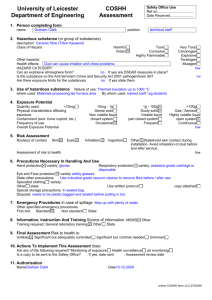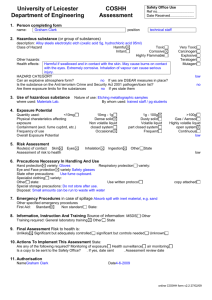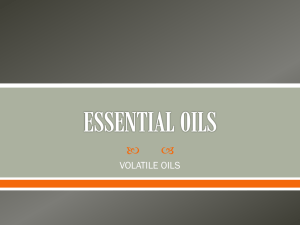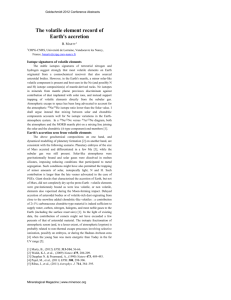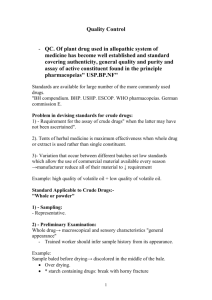vol oil final
advertisement
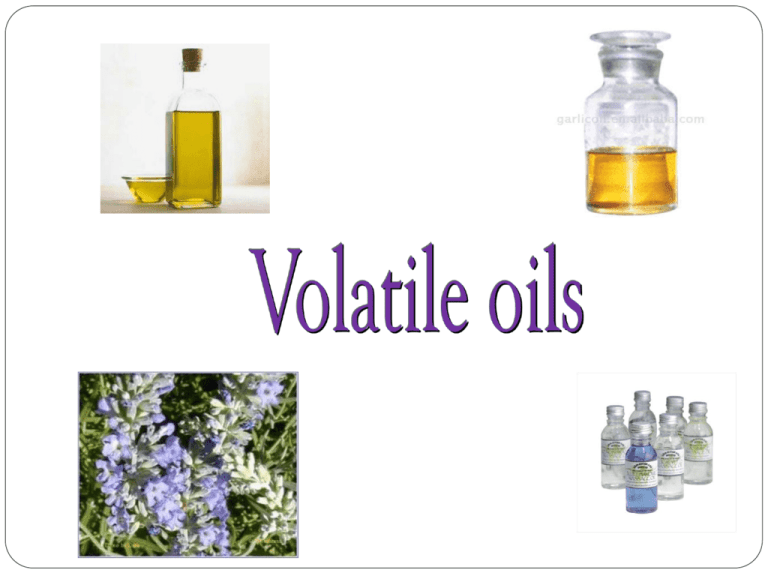
VOLATILE OILS Volatile or essential oils are volatile in steam. They differ entirely in both chemical and physical properties from fixed oils. They are secreted in: oil cells e.g. Cinnamon Oil glands e.g. Clove Secretion ducts (vittae) e.g. Anise Glandular hairs e. g. Chamomile They are frequently associated with other substances such as gums ( oleo gum) and resins (oleoresin) or both (oleo gum resin) Production and Uses of Volatile Oils There are about 100 commercially valuable volatile oils directly derived from plants. Volatile oils are used: 1- For their therapeutic action: antiseptic e.g. thyme and clove, carminative e.g. Mentha 2- Flavoring (e.g. oil of lemon), 3- in perfumery (e.g. oil of rose) 4- starting materials for the synthesis of other compounds (e.g. oil of turpentine). For therapeutic purposes they are administered as inhalations (e.g. eucalyptus oil), orally (e.g. peppermint oil), as gargles and mouthwashes (e.g. thymol) and transdermally (many essential oils including those of lavender, rosemary and bergamot are employed in the practice of aromatherapy). Those oils with a high phenol content, e.g. clove and thyme have antiseptic properties, whereas others are used as carminatives. Oils showing antispasmodic activity, and much used in popular medicine. e.g. fennel, mentha, caraway, chamomile, anise, rosemary. Composition of Volatile Oils Volatile oils are generally mixtures of hydrocarbons and oxygenated compounds derived from these hydrocarbons. The odour and taste of volatile oils is mainly determined by these oxygenated constituents, which are to some extent soluble in water but more soluble in alcohol. Practically all volatile oils consist of chemical mixtures that are often quite complex; they vary widely in chemical composition. Almost any type of organic compound may be found in volatile oils (hydrocarbons, alcohols, ketones, aldehydes, ethers, oxides, esters, and others). It is not uncommon for a volatile oil to contain over 200 components, and often the trace constituents are essential to the odor and flavor. The absence of even one component may change the aroma. Determination of the structure of terpenes Chemical constituents of volatile oils may be divided into 2 broad classes based on their biosynthetic origin: 1- Aromatic compounds formed via shikimic acid. These contain C6 phenyl ring with an attached C3 propane side chain. 2- Terpene derivatives formed via acetate mevalonic pathway. Classification of constituents of volatile oil: 1- Hydrocarbons - Unsaturated acyclic hydrocarbon eg. myrcene -Aromatic hydrocarbon eg. p-cymene Monocyclic eg. limonene which occur in citrus fruit, mint, thyme. Bicyclic eg. α-pinene found in lemon, anise, eucalyptus, thyme, fennel. * Limonene and α-pinene are biosynthesised from terpene pathway. - Sesquiterpene eg. Chamazulene 2- Alcohols: -Eg. Linalool, Citronellol Aromatic alcohol eg. benzyl alcohol 3- Ketones: Camphor occurs in rosemary, lavender. Uses: topical antipruritic, rubefacient, anti-infective. Rosemary Lavender 4- Esters: -Methyl salicylate * Methyl salicylate also this oil is known as wintergreen oil. Uses: methyl salicylate has local irritant, antiseptic, antirheumatic properties. 5- Phenols: CH3 OH H3C CH3 Thymol Eugenol, Thymol are the most important phenol present in volatile oil. Eugenol occur in clove oil and in cinnamon bark. Uses: as dental analgesic, antiseptic, counter irritant, carminative. Eugenia caryophyllus CH3 Thymol occurs in Thyme oil. OH Uses: antifungal, antibacterial agent. H3C CH3 Thymol Phenolic ether volatile oil Safrole from myristica or nutmeg uses: flavoring agent and carminative. Physical Properties Although volatile oils differ greatly in their chemical constitution, they have a number of physical properties in common: 1. They possess characteristic odors. 2. They are characterized by high refractive indices. 3. Most of them are optically active. 4. Their density is generally lower than that of water (the essential oils of sassafras, clove, or cinnamon are the exceptions). 5. As a rule, volatile oils are immiscible with water, but they are sufficiently soluble to impart their odor to water. The aromatic waters are dependent on this slight solubility. Preparation of volatile oils 1. 2. 3. 4. 5. The principal methods used in the preparation of volatile oils from plants depend on: Distillation in water or steam. Scarification and expression. Extraction with solvents. Enzymatic hydrolysis (for glycosidic volatile oils e.g. mustard oil). Enfleurage (extraction of oils used in perfumery). I- Distillation Methods: • There are two types of traps: One for oils lighter than water and the other for oils heavier than water. • These two types differ only in the mechanism of the return of the aqueous layer to the distillation flask, keeping the volatile oil layer in its position. Types of distillation used: 1-Water and steam distillation 2-Direct steam distillation Clevenger apparatus for volatile oil preparation Points for consideration in the distillation method: 1- It is often necessary to subject the plant material to special treatment prior to steam distillation e.g. cut or crushed. Crushing or cutting facilitates penetration of water into oil- containing structures in the plant. eg. Oil cells, glandular hairs. 2- For removal of water or moisture which might be present in the prepared volatile oil, anhydrous sodium sulfate is usually used. Some volatile oil can´t be distilled without decomposition and are usually obtained by: II- Expression method Expression can be carried out by means of any of the following three processes: a) Sponge method: - The citrus fruit (orange, lemon) is washed, cut into halve and the juicy part removed. - The rind is squeezed, when secretion glands rupture and the oil collected by mean of the sponge, until the sponge becomes saturated with water and oil. - The sponge is then periodically squeezed in a vessel. - The upper oily layer in the vessel is separated. b) Scarification method: - Citrus oil involve puncturing the oil glands by rolling the fruit over a trough lined with sharp projection that are long enough to penetrate the epidermis. - By repeatedly rotating the instrument after placing lemons in the bowel the oil glands are punctured (scarified) and discharge their contents which collect in the handle. - The liquid is poured off at interval into a large vessel, where it is allowed to stand until the oil can be decanted and filtered. c) Machine processes: - These machine methods have now almost completely replaced the old hand methods. A centrifuge may be used to separate the emulsion of oil and water. III- Extraction method - This method is used for the preparation of those oils which decompose by the action of steam or are present in extremely small quantities in plant organs containing them. - The minute quantities of oil actually distilling over, are lost in the large volume of distillation water from which the oil cannot be recovered. - This is applied to flowers such as jasmine, gardenia, violet, and few others. - The method of extraction is carried out using: a) Volatile solvents of low boiling point such as hexane. b) Non-volatile solvents such as fat (lard). a) Extraction with volatile solvents - The material containing the volatile oil is extracted with the volatile solvent with low boiling point by percolation. - The volatile oil solution obtained is evaporated under reduced pressure, where the volatile solvent will evaporate, leaving the volatile oil behind although some of the volatile oil will be lost. Advantage of extraction over distillation: - Uniform temperatures (usually 50°C) can be maintained during most of the process. But the distillation method is a low-cost operation compared to the extraction process. a- Extraction with volatile solvents: Floral concrete: - In preparing volatile oil with volatile solvents e.g. hexane, pet.ether the completely concentrated and purified products represent the so called floral concretes. - These floral concretes contain the odoriferous principles of the natural flower perfume plus a considerable amount of plant waxes and color pigments. - The concretes are solid and only partly soluble in alcohol 95%. Absolute: - By ppt. and eliminating the insoluble waxes from the floral concretes with strong alcohol and concentrating the filtered alcoholic solutions. B- Extraction with non-volatile solvents: This process is used for the preparation of: * Natural flower oils, where the volatile oil content of the fresh plant is so small, very expensive, for production of perfumes. 1- Enfleurage method - A mixture of melted lard is thickly smeared on both surfaces of each of the glass plates which are enclosed in a wooden frame. - Each glass plate is sprinkled with flowers to cover its top. - The plates are left for 24 hours. - The flowers are then removed and replaced by a fresh supply. - This is repeated until after some weeks, the fats becomes saturated with essential oil of the flowers. - The flowers are then removed and then fat is separated off and is stirred with absolute alcohol which will take the volatile oil and leave the fat being insoluble in alcohol. - The alcoholic extract is carefully cooled and filtered to remove any traces of fat which might remain in solution. 1- Clove (Caryophylli) Origin: the dried flower buds of Syzygium aromatica , Eugenia aromaticum or Eugenia caryophyllus F. Myrtaceae Morphology: reddish brown, 16-21 mm long, the lower stalk like portion (hypanthium which is an extension of the receptacle) is about 10-13 mm long, terminating in 4 triangular sepals and a dome- shaped head of 4 unexpanded petals enclosing other parts of the flower. Powder: dark brown, with strong aromatic spicy agreeable odour and warm spicy agreeable taste followed by numbness sensation in the mouth 1. Epidermal cells of sepals, petals and hypanthium showing anomocytic stomata. 2. Oil glands. Parenchyma with cluster crystals of calcium oxalate. 4. Xylem vessels and fibres. 3. 5. Fibrous layer of anther and elongated cells of the filament. 6. Pollen grains: triangular with truncate apices. Active constituents: 1. Volatile oil (15 -20%) contains eugenol (85%). 2. Pyrogallol tannin. Uses: 1. Local anesthetic for toothache. 2. Antispasmodic and carminative. 3. Spice. 4. In manufacture of vanillin. Chemical test: 1- Test for oil using Sudan III → red colour. 2- FeCl3 → blue colour. 3- KOH: needle crystals of K eugenate. Adulteration of clove: 1. Expanded flower 2. Mother clove (fruit): characterized by the presence of starch. 3. Exhausted clove: lighter than water. 4. Clove stalk: presence of prisms of calcium oxalate and pseudo crystal sheath. 2- German chamomile Origin: the dried expanded flower heads of Matricaria chamomilla F. Compositae (Asteraceae). Morphology: flower head (capitulum) is hemispherical with hollow receptacle carrying two types of small sessile flowers called florets: Marginal or ray florets (white in colour) Central or disc florets (yellow in colour) Surrounded by an involucre. Active constituents: 1- volatile oil contains matricarin which converted to chamazulene by heating. 2- flavonoid glycosides. Uses: 1- carminative, antispasmodic. 2- tranquilizer. 3- local anti-inflammatory for sun burns and diaper rashes. Chemical test: sudan III : red colour 3- Anise Fruit (Fructus Anisi, Aniseed) Origin: the dried ripe fruits of Pimpinella Anisum F. Umbelliferae Morphology: cremocarp, partly separated into its mericarps, often entire attached to a slender pedicel, 2-12 mm long, ovoid, enlarged at the base and tapering at the apex, grayish or greenish grey in colour rough to touch due to the presence of hairs, each mericarp with 5 raised ridges. Powder: grey, greenish brown or yellowish brown, having strong aromatic agreeable characteristic taste and sweet strongly aromatic taste, showing fragments of: 1. non-glandular, unicellular warty hairs. 2. Branching vitta usually crossed by the cells of the endocarp. 3. Aleurone grains. 4. Microrosette crystals of calcium oxalate. 5. Few fibres and pitted parenchyma. Active constituents: 1- volatile oil containing anethol 2- fixed oil and protein. Uses: stimulant, carminative and flavoring agent. Chemical test: Sudan III 4- Cinnamon Bark (Cortex Cinnamomi) Origin: the dried bark of the branches of the coppiced trees of Cinnamomum zylanicum F. Lauraceae. deprived of most of its cork and cortex and known as Ceylon Cinnamon. Morphology: occurs in long, slender sticks about 1 meter in length, compound quills. Powder: a reddish brown powder with a characteristic pleasant and aromatic odour and taste, showing fragments of: 1. Sclereids, isodiametric, thick wall, lignified, the outer wall is less thickened than the others. 2. Fibres, thick walled lignified, narrow lumen, slit-shaped pits and pointed apices. 3. Starch granules and needle crystals of calcium oxalate. 4. Oil cells. 5. Cork cells are rare. Active constituents: 0.5-1% volatile oil contains cinnamaldehyde and eugenol Mucilage and tannins. Uses: 1- carminative and flavoring agents 2- Antiseptic and mild astringent. 3- Emmenagogue. Chemical test: Sudan III, Rhuthenium red, FeCl3 and KOH for eugenol. 5- Cassia Bark (Chinese Cinnamon) Origin: the dried stem bark of Cinnamomum cassia F. Lauraceae Morphology: channeled or single quills, up to 40 cm long, earthy brown colour with patches of the thin grayish cork. Powder: differs than cinnamon in: 1. Odour is less delicate, taste as cinnamon but slightly mucilaginous. 2. Numerous fragments of cork cells, polygonal with slightly thick wall, contains reddish brown content. 3. Fibres are shorter and thicker. Active constituents: volatile oil contains cinnamaldehyde and no eugenol. Uses: substitute for cinnamon. Chemical test: all as cinnamon but negative test for eugenol ***6- Cardamom Seed (Semen Cardamomi) الهيل- حب الهال-حبهان Origin: the dried ripe or nearly ripe seeds of Elettaria cardamomum F. Zingiberaceae, recently separated from the fruit. Morphology: cardamom has a strong aromatic odour and agreeable aromatic pungent taste. Fruit is ovoid or oblong capsule, green to pale buff in colour contains many seeds. Seed is oblong, ovoid pale ornge to dark reddish brown usually enveloped by a thin colourless membranous arillus. Active constituents: 1- volatile oil contains terpinyl acetate and cineole. 2- starch, fixed oil and calcium oxalate Uses: 1- flavoring agent in pharmaceutical industry. 2- spice Chemical test: Sudan III Adulterants: 1. Loose seeds: they yield less volatile oil than those which stored in the pericarp until required for use. 2. Cardamom husk: characterized by the presence of fibres, sclereids and large vessels which are absent in the seeds. 7- Mentha Herb (Peppermint) (Herba Mentha Piperitae) Origin: the dried leaves and flowering tops of Mentha piperita F. Labiatae Powder: green to light olive green, with an aromatic characteristic odour and an aromatic taste followed by a sensation of cold in the mouth. It is characterized microscopically by the presence of fragments of: 1. Epidermal cells with wavy walls and diacytic stomata. 2. Non-glandular hairs. 3. Glandular labiaceous hair, unicellular stalk multicellular head consists of 8-16 cells radiating from a common center. 4. Different types of xylem vessels, fibres and wood parenchyma. 5. Smooth spherical pollen grains. 6. NO CALCIUM OXALATE. Active constituents: 1- volatile oil contains menthol 2- tannin. Uses: 1. carminative, flavoring agent and aromatic stimulant. 2. Menthol is used in pharmaceutical preparations as local antipruritic, counter irritant and antiseptic. 3. Used in tooth paste, mouth wash and similar oral preparations. 4. Recently the oil is used for treatment of colitis. Chemical test: Sudan III 8- Ginger, Zingiber, Zanjabeel (Rhizoma Zingiberis) Origin: the dried rhizome of Zingiber officinale F. Zingiberaceae, deprived of the dark outer tissues and known as unbleached Jamaica ginger. Morphology: ginger occurs in horizontal laterally flattened branching pieces, 4-16 cm long,1.5-6.5 cm wide and up to 2 cm thick, pale buff or light brown, longitudinally striated. It has an agreeable aromatic odour and an agreeable pungent aromatic taste. Powder: powdered ginger is yellowish white having an agreeable aromatic odour and an agreeable aromatic pungent taste. Microscopically, it is characterized by the presence of: 1. thin walled parenchyma containing starch granules. 2. Starch granules: simple, flat, oval, oblong with terminal protruberance in which eccentric hilum is situated with transverse striations. 3. Thin walled septate fibres. 4. Non-lignified xylem vessels. 5. Yellowish brown oleo-resin masses, free or in cells. 6. Absence of scleried cells or calcium oxalate. Active constituents: 1. volatile oil contains monoterpenes (phellandrene, camphene, cineole, citral and borneol) and sesquiterpenes (zingiberene and bisabolene). 2. Resin, starch and mucilage. Uses: 1. carminative and stimulant. 2. Antiemetic. 3. Antirheumatic. 4. Condiment.



